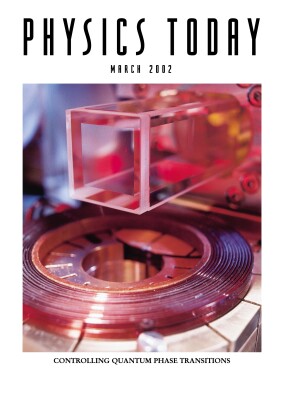Neutrino Detector Lab Looking Good
DOI: 10.1063/1.1472386
In an old hematite mine far below the ragged landscape of Minnesota’s Iron Range, workers have installed about one-quarter of the 486 octagonal steel “planes” that will make up the 5500-ton “far detector” for Fermilab’s Main Injector Neutrino Oscillation Search experiment. The $40 million detector, located in a newly excavated chamber in the Soudan Mine, will be the target for a neutrino beam line being constructed 730 kilometers away at Fermilab.
The MINOS experiment is part of the Fermilab’s “neutrinos at the main injector” project. The $167 million project includes the construction of a “near detector” and the new Fermilab beam line, as well as the far detector at Soudan. By firing the neutrinos through the near detector to the far detector, physicists hope to measure neutrino oscillations that will provide evidence about the mass of the elusive particles. Physicists hope the far detector, made of alternating planes of steel and plastic scintillator strips, will detect about 9000 neutrino interactions out of the 5 trillion neutrinos that pass through it each year.
For about 15 years, the Soudan site has been the home of the Argonne–Minnesota–Oxford–Rutherford–Tufts Soudan proton-decay detector, housed in a room adjacent to the new neutrino detector. To install the neutrino detector, a chamber about 690 meters underground was excavated, creating a room 84 m long, 16 m wide, and 14 m high. The steel detector planes, each about 8 m in diameter, are constructed horizontally on the lab floor, as shown in the photo, then stood vertically and moved into position in the detector. The detector is expected to be completed in late spring of next year. The first firing of neutrinos is expected in about two and a half years.
In addition to being a science laboratory, the Soudan Mine attracts some 40 000 visitors each year to the labyrinth of ore mine tunnels. As part of a public outreach effort, the Minnesota legislature funded a visitors’ gallery in the neutrino lab, and the University of Minnesota physics department commissioned the 8-by-18-meter mural on the wall opposite the gallery, shown about 25% complete in the photo. The mural, by artist Joseph Giannetti, symbolizes the formation and expansion of the universe.

DULUTH NEWS TRIBUNE

More about the Authors
Jim Dawson. American Center for Physics, One Physics Ellipse, College Park, Maryland 20740-3842, US .
